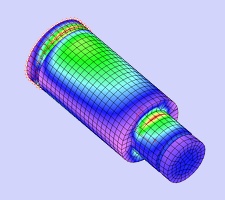| MEGR
493
Introduction to Finite Elements
Description:
Understand and apply finite element
methods to mechanical engineering problems.
Develop working knowledge on how to formulate
finite element solutions using direct stiffness
and weighted residual methods (including least-square,
collocation and Galerkin’s formulations)
to problems in structural mechanics and heat
transfer. Solve 1-D and 2-D FEM solution with
hand-calculation and MATLAB™. Practical
use of commercial finite element analysis software
COSMOS™ is also introduced. (fall) |

|
Who
takes it: Junior/senior mechanical engineering
students interested in the topic, satisfies mechanical
engineering elective requirement. (elective).
Pre-requisite:
MATH 233 Linear Algebra, MATH 234 Differential
Equation (used extensively).
Course
objective: Student understand the mathematical
foundation of finite element analysis; doing hand-calculation
in 1-D; properly operate commercial FEA analysis package,
understand its limitation.
Textbook:
Introduction to the Finite Element Method: Theory,
Programming and Application, by Erik Thompson,
1st Edition (2004), ISBN: 0471267538
I
do not teach this course at the moment, so do not
purchase the book in advance (also, this book is
terse and the students hated it with a vangence).
Recommended self-study book for junior/seniors:
A First Course in Finite Element Method,
by Daryl L. Logan, 3rd Edition (2000), ISBN: 0-534-38517-6.
For better theoretical treatment for undergrad,
I like Introduction to the Finite Element Method
by Ottosen and Petersson, Prentice Hall; (1992);
ISBN: 0134738772. It is out of print, but you can
find it in bookseller websites or on Ebay.
Figure:
Von Mises stress distribution on a variable
diameter 6061 aluminum cylinder with fixed support
on the far surface and a downward shear force on front
surface (with ALGOR™).
|

